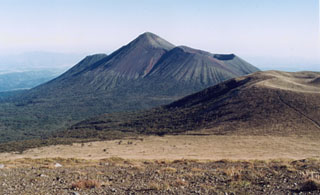Report on Kirishimayama (Japan) — 11 December-17 December 2024
Smithsonian Institution / US Geological Survey
Weekly Volcanic Activity Report, 11 December-17 December 2024
Managing Editor: Sally Sennert.
Please cite this report as:
Global Volcanism Program, 2024. Report on Kirishimayama (Japan) (Sennert, S, ed.). Weekly Volcanic Activity Report, 11 December-17 December 2024. Smithsonian Institution and US Geological Survey.
Kirishimayama
Japan
31.934°N, 130.862°E; summit elev. 1700 m
All times are local (unless otherwise noted)
The Japan Meteorological Agency (JMA) reported increasing unrest at Shinmoedake (Shinmoe peak, a stratovolcano of the Kirishimayama volcano group). The Global Navigation Satellite System (GNSS) indicated minor inflation starting in November 2023. The number of earthquakes with epicenters beneath Shinmoedake had been increasing since late October 2023; during 1-11 December 2024 the seismic network detected 284 earthquakes. At 1100 on 12 December the Alert Level was raised to 2 (on a 5-level scale) and the public was warned to stay 2 km away from Shinmoedake Crater. Sulfur dioxide emissions were below detectable limits on 3 and 9 December.
Geological Summary. Kirishimayama is a large group of more than 20 Quaternary volcanoes located north of Kagoshima Bay. The late-Pleistocene to Holocene dominantly andesitic group consists of stratovolcanoes, pyroclastic cones, maars, and underlying shield volcanoes located over an area of 20 x 30 km. The larger stratovolcanoes are scattered throughout the field, with the centrally located Karakunidake being the highest. Onamiike and Miike, the two largest maars, are located SW of Karakunidake and at its far eastern end, respectively. Holocene eruptions have been concentrated along an E-W line of vents from Miike to Ohachi, and at Shinmoedake to the NE. Frequent small-to-moderate explosive eruptions have been recorded since the 8th century.

